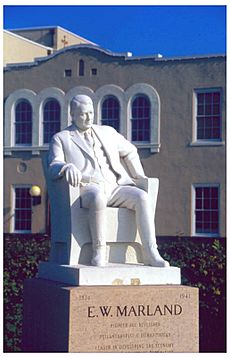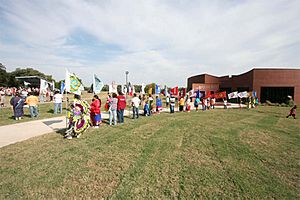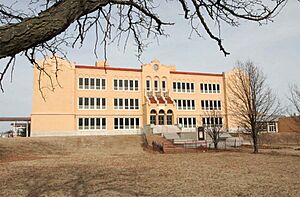Ponca City, Oklahoma facts for kids
Quick facts for kids
Ponca City, Oklahoma
Chína Uhánⁿdhe
|
|
|---|---|
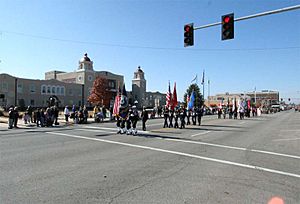
Veterans Day Parade down Grand Avenue in front of the Ponca City Civic Center and Town Hall
|
|
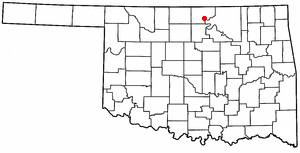
Location of Ponca City, Oklahoma
|
|
| Country | United States |
| State | Oklahoma |
| County | Kay |
| Founded | 1893 |
| Incorporated | 1899 |
| Government | |
| • Type | Council - Manager |
| Area | |
| • Total | 19.61 sq mi (50.78 km2) |
| • Land | 18.38 sq mi (47.60 km2) |
| • Water | 1.23 sq mi (3.19 km2) |
| Elevation | 1,017 ft (310 m) |
| Population
(2020)
|
|
| • Total | 24,424 |
| • Density | 1,329.05/sq mi (513.15/km2) |
| Time zone | UTC−6 (Central (CST)) |
| • Summer (DST) | UTC−5 (CDT) |
| ZIP codes |
74601-74604
|
| Area code(s) | 580 |
| FIPS code | 40-59850 |
| GNIS feature ID | 2411455 |
Ponca City (also known as Chína Uhánⁿdhe in the Iowa-Oto language) is a city in Kay County, Oklahoma. The city got its name from the Ponca tribe. In 2020, about 24,424 people lived in Ponca City.
Contents
History of Ponca City
Ponca City started in 1893 as "New Ponca." This happened after the United States opened the Cherokee Outlet for new settlers. This event was called the Cherokee Strip land run. It was the biggest land run in American history.
The spot for Ponca City was chosen carefully. It was close to the Arkansas River and a railway. There was also a freshwater spring nearby. Burton Barnes planned the city. He surveyed the land and sold tickets for the lots. After the land drawing, Barnes became the city's first mayor.
Another town, Cross, wanted to be the main city in the area. The Atchison, Topeka and Santa Fe Railway had a station in Cross. People thought they wouldn't build another one in Ponca City. But supporters of New Ponca offered the station agent two town lots. They also offered to move his house from Cross for free. People say Ponca City got its first train station by moving the one from Cross. Cross eventually disappeared. Today, it's a part of Ponca City. In 1913, New Ponca changed its name to Ponca City.
Oil Industry and Growth
The history and economy of Ponca City are closely linked to the oil industry. E. W. Marland, an oil businessman from Pennsylvania, came to Oklahoma. He started the Marland Oil Company. At one point, his company controlled about 10% of the world's oil reserves. In 1911, he drilled his first successful oil well. This was on land he leased from the Ponca tribe. Marland later became a U.S. congressman and then the governor of Oklahoma.
Marland's oil discoveries brought huge growth and wealth to the area. His company helped build the city from the ground up. Marland and his friends built large homes to show their wealth. These included the Grand Home and the E.W. Marland Estate. Because of this rich period, Ponca City has many buildings in the Spanish Colonial Revival architecture style. It also has buildings with Art Deco designs.
The "Roaring '20s" ended for Ponca City before the Great Depression. In the late 1920s, Marland Oil Co. joined with Continental Oil Co.. This new company was known as Conoco for over 70 years. Conoco kept its main office in Ponca City until 1949. It grew into a worldwide company.
In the 1980s, DuPont Corp. owned Conoco. DuPont sold Conoco in 1998. In 2002, Conoco joined with Phillips Petroleum to become ConocoPhillips. This was one of the largest oil companies in the world. ConocoPhillips still has a big presence in Oklahoma.
Over time, the company reduced its workers in Ponca City. This caused the city's population to shrink. In 2009, ConocoPhillips announced it would move most of its remaining operations out of the city. Ponca City has since worked to bring in new types of jobs. These include technology, manufacturing, and service jobs.
In 2005, ConocoPhillips planned to build a museum. The Conoco Museum opened in 2007. It shows items and photos about the oil industry. The museum is free to visit.
In 2012, ConocoPhillips split into two companies. One kept the ConocoPhillips name. The other, Phillips 66, handles refining and transportation. Phillips 66 still runs a large oil refinery in Ponca City.
Native American History
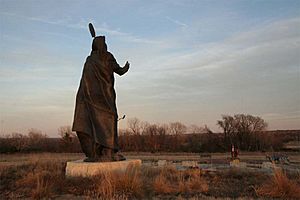
For a long time, stories about Ponca City focused on the settlers and the oil industry. But the area has a much older history. It was home to many Native American tribes. Many tribes were moved to Oklahoma in the 1800s.
Ponca City is named after the Ponca tribe. Some of the Ponca people were moved from Nebraska to northern Oklahoma between 1877 and 1880. This journey was very hard. The U.S. government did not provide enough supplies. Many Ponca people got sick with malaria. Nearly one-third of the tribe died from illness and hardship.
The Ponca people protested their conditions. In 1879, Standing Bear's oldest son died. The chief had promised to bury him in his homeland. About 60 Ponca people went back to Nebraska with him. The U.S. Army was ordered to arrest them. They were held at Fort Omaha. Most of the tribe members eventually went back to Oklahoma. But Standing Bear, with help from lawyers, challenged his arrest. The case, Standing Bear v. Crook (1879), was very important. The judge ruled that Native Americans had the same legal rights as other U.S. citizens.
A statue of Standing Bear stands in Ponca City to honor him. The city also has a park and museum named after him. The 63-acre park has walking trails and a pond.
The Ponca Nation has had its main office near Ponca City since 1879. They played a big part in the early oil industry. Chief White Eagle leased land to E.W. Marland in 1911 for oil exploration.
Since the late 1900s, the Ponca tribe has worked to improve life for its people. They have built new facilities and services.
Other nearby tribes include the Kaw, Osage, Otoe-Missouria, Pawnee, and Tonkawa. These are all officially recognized tribes. In 1994, these six tribes started the Standing Bear Foundation and Pow-wow. They hold annual pow-wows to bring tribes together. They also want to connect with non-Native residents of Ponca City. The pow-wow is now held in Standing Bear Park.
Geography and Climate
Ponca City is in southeastern Kay County, near the Arkansas River. The city covers about 18.4 square miles of land. It also has about 1.2 square miles of water.

The city is in north-central Oklahoma. It is about 21 miles south of the Kansas border. It is also about 15 miles east of Interstate 35.
Ponca City is close to the Arkansas River, the Salt Fork of the Arkansas River, Kaw Lake, and Lake Ponca. These places offer many fun outdoor activities.
Weather in Ponca City
Ponca City is in "Tornado Alley." Tornadoes are most common in April, May, and June. Summers in Ponca City are very hot and humid. Temperatures often go above 100 degrees Fahrenheit. The area also gets severe storms. Winters are mild to cold, with some snow and ice.
| Climate data for Ponca City, Oklahoma, 1991–2020 normals, extremes 1948–present | |||||||||||||
|---|---|---|---|---|---|---|---|---|---|---|---|---|---|
| Month | Jan | Feb | Mar | Apr | May | Jun | Jul | Aug | Sep | Oct | Nov | Dec | Year |
| Record high °F (°C) | 80 (27) |
92 (33) |
92 (33) |
101 (38) |
100 (38) |
110 (43) |
116 (47) |
112 (44) |
110 (43) |
98 (37) |
90 (32) |
83 (28) |
116 (47) |
| Mean maximum °F (°C) | 69.7 (20.9) |
76.0 (24.4) |
82.8 (28.2) |
87.9 (31.1) |
92.3 (33.5) |
98.1 (36.7) |
103.0 (39.4) |
102.6 (39.2) |
97.8 (36.6) |
89.6 (32.0) |
78.6 (25.9) |
70.0 (21.1) |
104.6 (40.3) |
| Mean daily maximum °F (°C) | 47.2 (8.4) |
52.0 (11.1) |
61.7 (16.5) |
70.6 (21.4) |
79.0 (26.1) |
88.3 (31.3) |
93.3 (34.1) |
92.1 (33.4) |
84.3 (29.1) |
72.5 (22.5) |
59.8 (15.4) |
48.9 (9.4) |
70.8 (21.6) |
| Daily mean °F (°C) | 35.9 (2.2) |
40.1 (4.5) |
49.5 (9.7) |
58.5 (14.7) |
68.1 (20.1) |
77.6 (25.3) |
82.4 (28.0) |
80.9 (27.2) |
72.7 (22.6) |
60.5 (15.8) |
48.1 (8.9) |
38.1 (3.4) |
59.4 (15.2) |
| Mean daily minimum °F (°C) | 24.6 (−4.1) |
28.2 (−2.1) |
37.3 (2.9) |
46.4 (8.0) |
57.2 (14.0) |
67.0 (19.4) |
71.4 (21.9) |
69.7 (20.9) |
61.1 (16.2) |
48.4 (9.1) |
36.4 (2.4) |
27.4 (−2.6) |
47.9 (8.8) |
| Mean minimum °F (°C) | 8.1 (−13.3) |
10.8 (−11.8) |
18.7 (−7.4) |
29.6 (−1.3) |
40.5 (4.7) |
54.5 (12.5) |
61.6 (16.4) |
58.3 (14.6) |
44.8 (7.1) |
30.1 (−1.1) |
19.0 (−7.2) |
10.6 (−11.9) |
3.0 (−16.1) |
| Record low °F (°C) | −12 (−24) |
−25 (−32) |
−2 (−19) |
19 (−7) |
30 (−1) |
44 (7) |
50 (10) |
49 (9) |
28 (−2) |
15 (−9) |
8 (−13) |
−10 (−23) |
−25 (−32) |
| Average precipitation inches (mm) | 1.02 (26) |
1.10 (28) |
2.17 (55) |
3.78 (96) |
5.10 (130) |
4.70 (119) |
3.70 (94) |
3.28 (83) |
2.74 (70) |
3.06 (78) |
1.65 (42) |
1.27 (32) |
33.57 (853) |
| Average snowfall inches (cm) | 2.3 (5.8) |
1.9 (4.8) |
1.8 (4.6) |
trace | 0.0 (0.0) |
0.0 (0.0) |
0.0 (0.0) |
0.0 (0.0) |
0.0 (0.0) |
trace | 0.4 (1.0) |
2.0 (5.1) |
8.4 (21.3) |
| Average precipitation days (≥ 0.01 in) | 4.8 | 4.9 | 6.9 | 8.2 | 10.4 | 8.7 | 7.4 | 7.5 | 6.9 | 6.8 | 5.1 | 4.6 | 82.2 |
| Average snowy days (≥ 0.1 in) | 1.8 | 1.5 | 0.9 | 0.1 | 0.0 | 0.0 | 0.0 | 0.0 | 0.0 | 0.1 | 0.3 | 1.7 | 6.4 |
| Source 1: NOAA (snow/snow days 1981–2010) | |||||||||||||
| Source 2: National Weather Service | |||||||||||||
People of Ponca City
| Historical population | |||
|---|---|---|---|
| Census | Pop. | %± | |
| 1900 | 2,528 | — | |
| 1910 | 2,521 | −0.3% | |
| 1920 | 7,051 | 179.7% | |
| 1930 | 16,136 | 128.8% | |
| 1940 | 16,794 | 4.1% | |
| 1950 | 20,180 | 20.2% | |
| 1960 | 24,411 | 21.0% | |
| 1970 | 25,940 | 6.3% | |
| 1980 | 26,238 | 1.1% | |
| 1990 | 26,359 | 0.5% | |
| 2000 | 25,919 | −1.7% | |
| 2010 | 25,387 | −2.1% | |
| 2020 | 24,424 | −3.8% | |
| Sources: | |||
In 2010, Ponca City had 25,387 people living there. There were 10,440 households. About 25.4% of households had children under 18. Many families were married couples.
The people in Ponca City come from different backgrounds. Most are White (84.18%). There are also African American (2.99%) and Native American (6.27%) residents. About 4.43% of the population is Hispanic or Latino.
The average age of people in Ponca City was 38 years old. About 26.2% of the population was under 18.
Economy and Jobs
E. W. Marland built the Ponca City refinery in 1918. He started the Marland Oil Company. In 1929, Marland Oil joined with the Continental Oil Company. The new company was called Conoco Inc.. Conoco's main office was in Ponca City until 1949.
In 2002, Conoco Inc. and Phillips Petroleum Company merged. They became ConocoPhillips. In 2012, ConocoPhillips split into two companies. One kept the ConocoPhillips name. The other, Phillips 66, handles refining and transportation.
The Ponca City Refinery, run by Phillips 66, is the largest refinery in Oklahoma. It turns different types of crude oil into products. These products include gasoline, diesel, and aviation fuels. The refinery gets its oil from pipelines in Oklahoma, Texas, and Canada. Finished products are sent by truck, train, and pipelines. They go to markets across the central United States.
Fun Things to Do
Sports History
Ponca City used to have minor league baseball teams. The Ponca City Poncans played in 1924. The Ponca City Angels played from 1934 to 1938. They won three championships. The Ponca City Dodgers played from 1947 to 1952. The Ponca City Jets played in 1954. The Ponca City Cubs played from 1955 to 1957. That was the last year for professional baseball in Ponca City.
Places to Visit
- 101 Ranch Memorial: A place to remember a famous ranch.
- Cann Memorial Botanical Gardens: Beautiful gardens to explore.
- Kaw Lake: A large lake for recreation.
- Marland Grand Home: One of E. W. Marland's grand houses.
- E. W. Marland Mansion: Another impressive home built by Marland.
- Pickens Museum: A museum with interesting exhibits.
- Ponca Tribe headquarters: The main office for the Ponca tribe.
- Standing Bear Memorial: A memorial honoring the Ponca chief.
Important Landmarks
Ponca City has several landmarks listed on the National Register of Historic Places. These include the Poncan Theatre, the Marland Mansion, and Marland's Grand Home. The city also hosts several events each year.
In 2024, Ponca City and Kay County were named a World War II Heritage City. This honors their contributions during World War II.
Pioneer Woman Statue and Museum
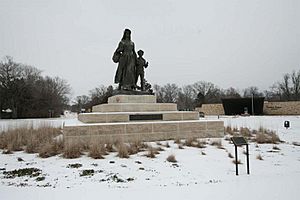
Ponca City is home to the Pioneer Woman Museum and the Pioneer Woman statue. The statue honors women who helped settle the American West. In the 1920s, E. W. Marland wanted to create a statue for these women.
He held a competition in 1927. Twelve sculptors from the U.S. and other countries submitted small models. These models were shown in 12 cities. About 750,000 people voted for their favorite. The original models are now at the museum at Woolaroc.
Bryant Baker, a British-born American sculptor, won the competition. His full-size statue was shown to the public on April 22, 1930. About 40,000 guests came to see it. The famous humorist Will Rogers spoke at the event. The statue is 27 feet tall and weighs 12,000 pounds. Its real name is "Confident."
A museum about Oklahoma women opened on September 16, 1958. This was 65 years after the Cherokee Strip land run. The museum celebrates the hard work of Native American and European-American women. It shows how they built homes, raised families, and helped their communities.
Education in Ponca City
Public Schools
Ponca City Public Schools serves most students in the city. Over 5,100 students attend these schools.
- High Schools
- Ponca City High School (Po-Hi): For students in grades 9-12.
- WildCat Academy Program: An alternative school for high school students.
- Middle Schools
- East Middle School: For eighth-grade students.
- West Middle School: For sixth and seventh-grade students.
- Elementary Schools
Ponca City has eight elementary schools for students from pre-kindergarten to fifth grade:
- Garfield Elementary
- Liberty Elementary
- Lincoln Elementary
- Roosevelt Elementary
- Trout Elementary
- Union Elementary
- McCord Elementary (also has sixth grade)
- Washington Elementary
Some small parts of Ponca City are zoned for Kildare Public School.
Private Schools
Ponca City has three private schools. They serve students from pre-kindergarten to eighth grade:
- Ponca City Christian Academy
- First Lutheran School
- St. Mary's Catholic School
Higher Education and Training
- Pioneer Technology Center: Offers training for high school students and adults. It also has programs with Northern Oklahoma College and Cowley County Community College.
- University Center (UC) at Ponca City: Offers online classes from several universities. These include Northern Oklahoma College and Northwestern Oklahoma State University. The UC also works to create STEM (Science, Technology, Engineering, Math) opportunities for younger students.
- Research
- Ponca City is home to Oklahoma State University's University Multispectral Laboratory. This is a research facility.
City Services and Transportation
Electricity
Ponca City gets its electricity from Kaw Lake. This lake is about 7 miles east of the city. It is a project by the United States Army Corps of Engineers. The electricity is managed by the Oklahoma Municipal Power Authority.
Transportation
You can reach Ponca City by several major roads. These include I-35, US-60, US-77, US-177, and OK-11.
Grand Avenue, a main street, has new streetlights. They are designed to look classic. Most traffic lights on Grand Avenue were also updated.
Airports
Ponca City Regional Airport (PNC) is located northwest of the city. It has a long runway. The airport has a booster club that hosts a "fly-in breakfast" every first Saturday of the month.
For commercial flights, you can go to Stillwater Regional Airport (about 40 miles south). Other options are Wichita Dwight D. Eisenhower National Airport (about 89 miles north) or Tulsa International Airport (about 101 miles southeast).
Famous People from Ponca City
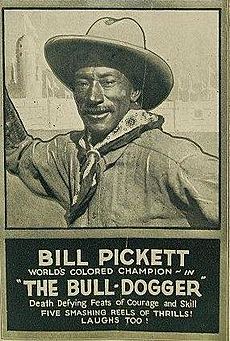
- Douglas Blubaugh: Olympic gold medalist in wrestling (1960).
- Mike Boettcher: News reporter for CNN and NBC.
- Lou Clinton: Major League Baseball (MLB) player.
- Don Coleman: College Football Hall of Fame offensive lineman.
- Stanley Ann Dunham: Mother of U.S. President Barack Obama.
- Terry Forcum: World Champion long drive golfer.
- Richard E. Killblane: Military historian and author.
- Jon Kolb: Former offensive lineman for the Pittsburgh Steelers.
- E. W. Marland: Businessman and politician.
- Gale McArthur: All-American basketball player.
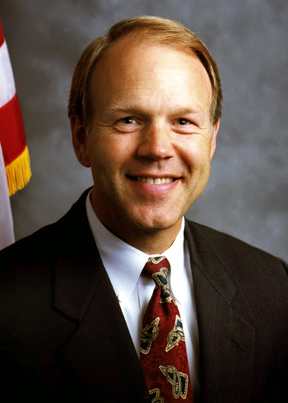
- W. H. McFadden: Oilman and helper of others.
- Jake McNiece: A U.S. Army paratrooper in World War II. He led the "Filthy Thirteen," a special unit that inspired the movie The Dirty Dozen.
- Don Nickles: Former United States Senator.
- Gayla Peevey: Child singer, known for "I Want a Hippopotamus for Christmas".
- Bill Pickett: Famous cowboy.
- Don Puddy: NASA flight director.
- Mark and Rusty Ryal: Father and son MLB players.
- Kareem Salama: Country and western singer.
- Clint Sodowsky: MLB player.
- Standing Bear: Important Ponca Native American leader.
- Anthony Taylor: Catholic bishop.
- Joyce Carol Thomas: Children's author.
- Marilyn Vann: Engineer and activist.
- Lew Wentz: Oilman and helper of others.
- Shelby Wilson: Olympic gold medalist in wrestling (1960).
- Waddy Young: All-American football player who flew B-29s in World War II.
Images for kids
-
The Poncan Theatre was built in 1927
Sister cities
 Baiyin, Gansu, China
Baiyin, Gansu, China
See also
 In Spanish: Ponca City (Oklahoma) para niños
In Spanish: Ponca City (Oklahoma) para niños



